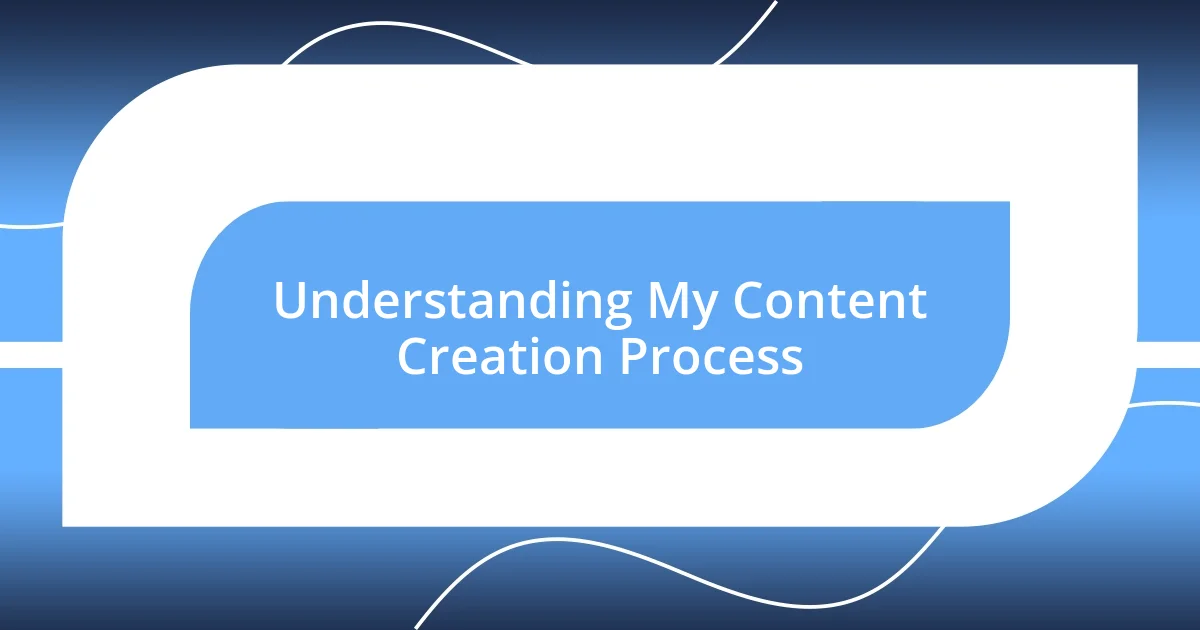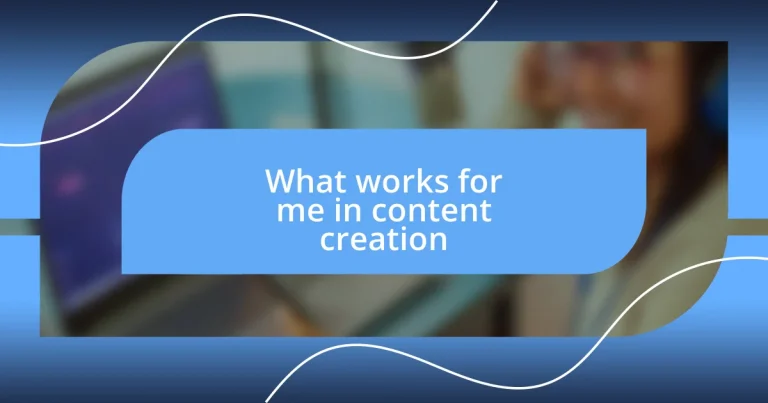Key takeaways:
- Effective content creation begins with brainstorming and clarity, focusing on audience needs and simplifying complex topics.
- Choosing the right content format enhances engagement; experimentation with formats like blogs, videos, and podcasts allows for tailored audience connections.
- Promoting content through social media, email marketing, and collaborations expands reach, while analyzing results and feedback informs necessary adjustments for improvement.

Understanding My Content Creation Process
When I dive into content creation, I begin with brainstorming sessions where I allow my thoughts to flow freely. It’s a bit like sketching—no judgment, just creativity spilling onto the page. Sometimes, I ask myself, “What resonates with my audience?” This question often leads me down unexpected paths, uncovering ideas I might not have considered before.
After brainstorming, I prioritize clarity. I’ve found that distilling the essence of my thoughts into clear, concise points helps to convey my message effectively. For example, when writing about a complex topic, I break it down into bite-sized pieces. I remember a time when I struggled to articulate a concept, and simplifying it not only clarified my own understanding but also made it more accessible for my readers.
Once I have my ideas structured, I embrace the editing phase with open arms. I treat it like sculpting—each edit refines and sharpens my work. I ask myself, “Does this truly reflect my voice?” This introspection is crucial; it’s how I ensure the final piece feels genuine and relatable, inviting the reader into my world rather than distancing them with overly polished jargon.

Identifying My Target Audience
Identifying my target audience is a crucial step in my content creation journey. I remember when I first started writing, I struggled to engage with my readers because I simply didn’t understand who they were. By actively diving into demographic research and analyzing engagement metrics, I learned that my audience mostly consists of young professionals seeking practical tips and relatable stories. This insight dramatically shaped my content, allowing me to create more tailored messages that resonate.
To help me further understand my audience, I developed a checklist that I refer to often:
- Age and gender demographics
- Interests and hobbies
- Pain points and challenges
- Preferred content formats (videos, blogs, podcasts)
- Feedback from previous content
By keeping this list handy, I ensure each piece I create speaks directly to the needs and desires of my audience. This connection has made my writing feel more purposeful and impactful, turning casual readers into a loyal community that I deeply cherish.

Choosing the Right Content Format
Choosing the right content format is a pivotal decision in my creation process. I often consider whether a blog post is appropriate, or if a video would better capture my audience’s attention. For instance, I once transformed a complicated tutorial into a brief video. The engagement skyrocketed, and I realized how vital format choice is in connecting with my readers.
In my experience, matching the content format to the message can transform the audience’s perception. For example, I remember creating an infographic to convey statistics—visuals made the data much more digestible. When I’m faced with a similar situation in the future, I won’t hesitate to opt for visuals over lengthy texts, knowing the power they wield in holding attention.
Ultimately, I’ve learned that it’s about experimenting and evolving. When I initially tried out podcasting, I found it challenging to adjust my writing style for the spoken word. Nevertheless, the feedback suggested listeners craved that personal touch. Understanding that different formats can deliver varying levels of intimacy has helped me refine my approach.
| Content Format | Best Use Case |
|---|---|
| Blog Posts | In-depth analysis and written storytelling |
| Videos | Visually engaging demonstrations and tutorials |
| Podcasts | Personal conversations and storytelling |
| Infographics | Quick data representation |

Planning and Organizing Content Ideas
When it comes to planning and organizing my content ideas, I’ve found that a clear structure is essential. I create a simple outline before diving into writing, which helps me map out the main themes and subtopics. I once had a moment of panic while writing a multi-part series. Without a solid plan, I felt lost and scattered. By sketching out my thoughts, I transformed that overwhelming chaos into a logical flow, which not only eased my mind but also enhanced the final product.
Visual tools like mind maps have become my secret weapon for organizing ideas. I vividly recall sitting in a coffee shop, brainstorming ideas for a new project, and mapping out my thoughts on a napkin. It felt liberating to see how concepts connected and branched out. Did you ever have that moment when everything just clicks? That’s what a good visual organization tool can do for you—it turns a cluster of thoughts into a cohesive narrative.
Reviewing past content has also become a part of my planning process. When I look back, I notice trends in what resonated most with my audience. For instance, I once revisited some posts that received a lot of interaction, and it struck me how my readers responded to storytelling versus straightforward advice. This reflection guides my future content creation, ensuring I consistently deliver what my audience craves. How do you decide which ideas to prioritize? For me, it’s all about tuning in to the rhythm of my audience’s preferences.

Techniques for Effective Writing
When it comes to effective writing, one technique that has significantly impacted my process is the use of active voice. I remember the first time I made this switch; it was like someone turned on a light in a dim room. Active voice creates a stronger connection with the reader, making sentences punchier and more direct. For instance, instead of saying “The project was completed by our team,” I learned to say, “Our team completed the project.” Doesn’t that sound more engaging?
Another technique I find invaluable is “show, don’t tell.” When crafting narratives, I strive to immerse my readers in the experience. I recall recounting a moment during a conference where the excitement was palpable. Instead of simply stating, “Everyone was excited,” I described the buzz in the air, the smiling faces, and the palpable energy in the room. This approach helps readers visualize the scene and feel the emotions, creating a deeper engagement.
Lastly, I swear by the power of revision. The first draft is often just a raw sketch of my ideas. I remember feeling so proud of a piece I wrote, only to realize upon revisiting it that the structure was off, and some points needed clarity. Taking a step back and refining the content not only sharpens my message but often uncovers new insights I hadn’t considered initially. Have you ever had that eureka moment after revising? I can’t stress enough how transformative the editing process can be for effective writing.

Promoting Content for Maximum Reach
When it comes to promoting content for maximum reach, I find that leveraging social media platforms is crucial. I once shared a piece on LinkedIn that unexpectedly gained traction, largely because I tailored the message to fit the platform’s professional vibe. It made me realize how essential it is to not just throw content out there but to actively engage with the audience in a manner that resonates with them. Have you experienced the difference in engagement when you adjust your approach for each platform?
Email marketing is another tool I swear by. I remember launching a newsletter filled with exclusive insights and tips. The response was incredible, and it reminded me how personal touch can make a significant difference. When you directly connect with your audience through their inbox, it feels like you’re having a one-on-one conversation. Making it easy for subscribers to share that content amplifies your reach, too—think about the potential growth when your audience becomes your advocates.
Lastly, collaborating with others in your niche has been a game changer for me. I recall partnering with a fellow content creator for a webinar, and we both promoted it through our channels. The cross-pollination of audiences not only increased our reach but also enriched the content. It’s fascinating to see how working together can elevate both parties’ visibility. How have collaborations worked for you in expanding your audience?

Analyzing Results and Making Adjustments
To truly harness the power of content creation, analyzing results is essential. I remember reviewing the analytics for a blog post that I thought would be a hit. To my surprise, the engagement was significantly lower than expected. This prompted me to dig deeper—what had gone wrong? I adjusted my headline and promoted it with a fresh focus, ultimately leading to a much greater response.
The adjustments I make after analyzing results often come from listening to feedback. For instance, after a webinar, I received comments about the pacing. I took this to heart, and during my next session, I incorporated breaks for questions and discussions. This change not only improved the flow but also fostered a sense of community among participants. Isn’t it rewarding when adjustments directly enhance audience interaction?
I’ve also learned the importance of testing different approaches. One time, I experimented with various formats for my newsletters, alternating between long articles and bite-sized tips. By closely monitoring open rates and click-through data, I discovered that the concise format resonated more. Realizing this transformed my strategy and made my content much more effective. How do you decide what adjustments to make when results don’t meet your expectations? Your insights could lead to some powerful shifts in approach!












